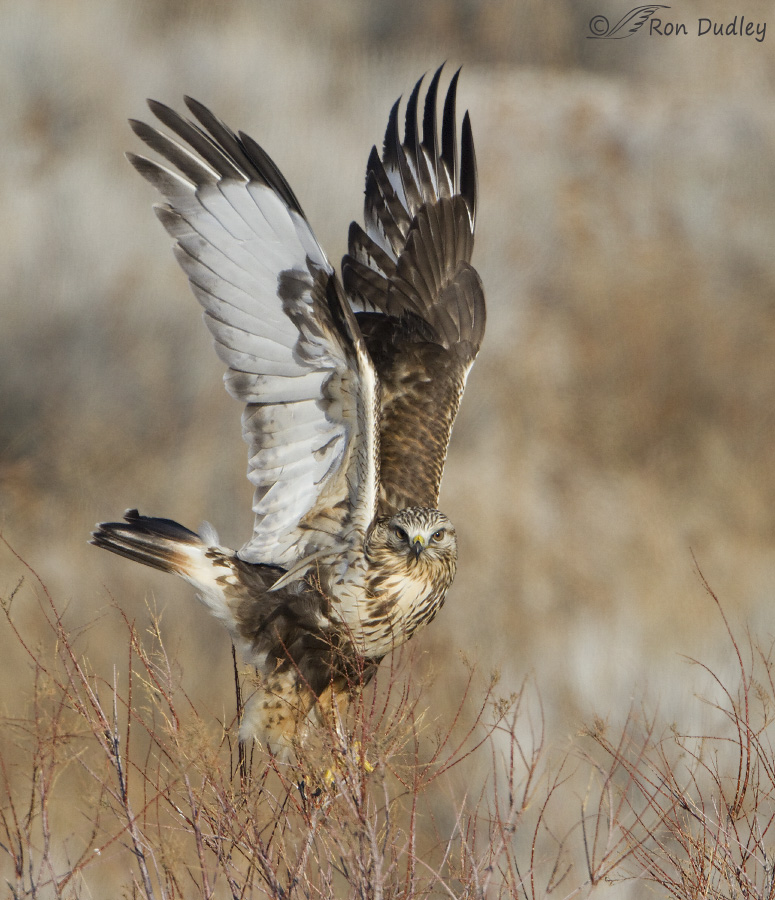This Rough-legged Hawk taught me a little trick that has improved my keeper rate for takeoff shots.
 1/3200, f/6.3, ISO 500, Canon 7D, Canon EF 500mm f/4L IS USM + 1.4 tc, not baited, set up or called in
1/3200, f/6.3, ISO 500, Canon 7D, Canon EF 500mm f/4L IS USM + 1.4 tc, not baited, set up or called in
I love the dramatic vertical wing lift as this bird took off from a tree on Antelope Island but I was very lucky to avoid clipping its wings with them in this position. In my experience it’s somewhat unusual for buteos to raise their wings this high as they lift off so as I was reviewing my images later that day I pondered over this one, wondering why it had done so.
One thing I noticed was that the bird had settled down into the perch so that many of the branches and twigs of the tree were higher up than much of the body of the hawk. This meant that the bird needed as much lift as possible to clear those branches at takeoff – thus the high wing position.
So now whenever I have my lens trained on a large, perched hawk that is likely to take off soon and it’s perched so that it has obstructions in its probable takeoff path I always try to frame the bird with extra room up top so that I’m less likely to clip those expansive wings in a vertical position. I’m so fond of that posture that I really want to avoid clipping body parts whenever possible.
That lesson has served me well in the four years since I took this image so I thought I’d pass it along.
Ron


Beautiful photo–as usual.
Jack the Harris’ hawk demonstrates that maneuver several times in any given hunt around here. He manages to get into some of the deepest brush tangles chasing the Mighty Voles, and darn if he doesn’t just lift himself out without much of a problem. But the various thorny/tangly stuff is mostly over his head, too. Those vertical flights are great muscle builders along with the hover flights. No, hovers are not just for Kestrels. Even redtails hover when they’re mousing. 😀
Magnificent shot!
Charlotte
How I love your teacher…
Well, I love to teach, EC. Got it in my blood I guess.
Wonderful photo! Happy Easter Ron.
Same to you, Debbie. Thanks.
Great shot, and thanks for the tip! I will keep that in mind next time I’m practicing takeoff shots of our Red-tail. Still trying to get a decent shot of a flying Harrier.
Good luck with the harriers, Dick. They’re a difficult subject as you well know.
Awesome shot!!
Thank you, Melissa.
I bought a wonderful, detailed, chainsaw carving of a hawk with a similar wing position in Arizona many years ago and have often wondered if they ever lifted their wings this high and if so, under what circumstances…finally got my answer….thanks! My hawk is in an almost identical position, even to the turn of the head…to the right. The sculptor was parked by the side of the road with some amazing stuff. We got to talking and he offered me the hawk for a very low price because the tip of one of the left side primaries was a little shorter than the others, otherwise, it’s perfect. I wondered if it was a “gift”. Incertainly considered it one…(later read he’d carved an large eagle for whoever was the president at the time…don’t remember which one)…
Patty, I hope you still have that carving. It sounds wonderful!
I do and it is…wish i knew how to send stuff on this evil thing….
Wow—-so beautiful, and also the best clear view of wing anterior anatomy I’ve yet seen……..thanks !
“the best clear view of wing anterior anatomy I’ve yet seen”
I see what you mean, Kris. Good point.
Thanks for the tip Ron. I usually try to give plenty of room above a perched hawk for the wings, however I did not pay attention to the vegetation around the hawk as guidance on the expected wing positions. Great idea. I love the look on the hawk’s face, its voice bubble would say “Ron, make sure you capture my beautiful wings” :-). Which you did!
Those wings are something else, aren’t they, Ed. Thank you.
Beautiful shot and thanks for the tip.
You’re very welcome, Larry.
Beautiful photo and excellent tip, thanks Ron.
Thank you, Zaphir.
Gorgeous shot, Ron! 🙂 Also good lesson on what to look for in that situation. Does pay to take the time to be a good observer of the critters “habits” in these cases.
“Does pay to take the time to be a good observer of the critters “habits” in these cases.”
That’s for sure, Judy – especially when you’re a photographer.
Thanks, Ron. Gorgeous image and valuable lesson to remember. I tried some take-off shots of a Golden-crowned Kinglet yesterday but got skunked on that score. Close a couple times, but no cigar. I’ll just keep trying. And all my photos of eagles and hawks were trashed because of atmospheric turbulence so that’s why I decided to concentrate of the smaller birds. I can get closer to them in their stopover home of Magee Marsh which negated the turbulence problem.
Dave, I can’t imagine many birds more difficult to get at takeoff than a kinglet – they’re so very small and quick. You’ve chosen a worthy and challenging quarry!